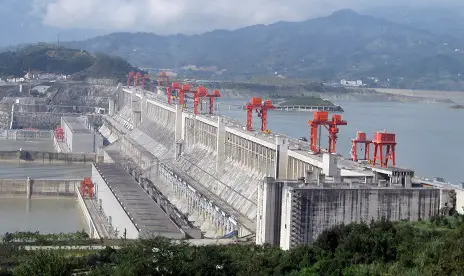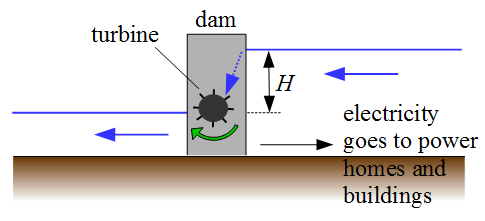Hydro Energy - For Kids

The Three Gorges Hydro-Electric Dam in China. Source: http://en.wikipedia.org/wiki/Three_Gorges_Dam. Author: http://commons.wikimedia.org/wiki/File:ThreeGorgesDam-China2009.jpg
Hydro energy is the energy from falling water. The greater the falling height of the water, the greater the energy. Hydro-electric generating stations are the largest electrical generating stations in the world. The largest electric generating station in the world is the Three Gorges hydro-electric dam in China, shown above. It is a massive power station, with a length of 2.3 kilometers and a height of 180 meters. It is capable of generating 22,500 megawatts, which is enough electricity to supply a typical north american city with a population of 6 million people.
Hydro-electric stations consist of a dam which stretches across a flowing body of water, such as a river. The purpose of the dam is to "trap" a large amount of water behind it, and then release that water gradually and in a controlled way to produce electricity. The water behind the dam falls from a height equal to the height of the dam. Upon falling, this water travels to the bottom of the dam through a channel built into the dam. At the bottom of the dam the water impinges onto the blades of special turbines. This causes the turbines to turn and produce electricity.
The figure below shows a schematic of how hydro-electric power works. The water falls from a height H which is the elevation difference between the water level on both sides of the dam. This water then passes through turbines. This turns the turbine blades which generate electricity for use in homes and buildings. The greater the height H the more the water falls and the more electrical energy is produced.

Hydro energy is an example of gravitational energy, which comes from falling objects. Hydro energy would not be possible if not for the water cycle. The water that continuously flows through bodies of water, such as rivers, is only possible because of elevation differences (between connected bodies of water) and the water cycle. In the water cycle, the sun evaporates the water on earth, which later falls as rain. This maintains the flow rate between connected bodies of water, which are at different elevations. For example, if the water cycle did not exist, the water going over Niagara Falls would eventually stop flowing. To understand why, imagine water flowing between two tanks located outdoors. The tanks are connected to each other with a tube. One tank is placed at a higher elevation than the other and the water flows from this tank to the lower tank, through the tube. When it rains the tanks both fill up with water, and water then flows from the higher tank to the lower tank, until the higher tank is empty. In order for this process to continue it must rain again. Hydro-electric power works the same way. It needs continuous rain in order to allow water to keep flowing from high areas to low areas. Hydro-electric stations simply tap into the energy contained within this natural flow of water. And this is only possible because of the water cycle.
Return to Physics For Kids page
Return to Real World Physics Problems home page
Free Newsletter
Subscribe to my free newsletter below. In it I explore physics ideas that seem like science fiction but could become reality in the distant future. I develop these ideas with the help of AI. I will send it out a few times a month.